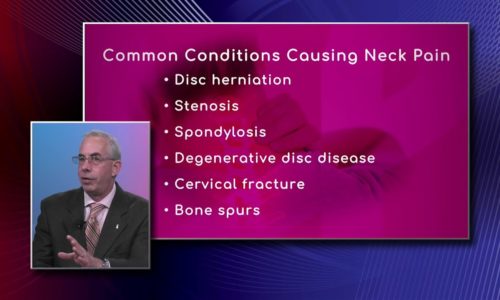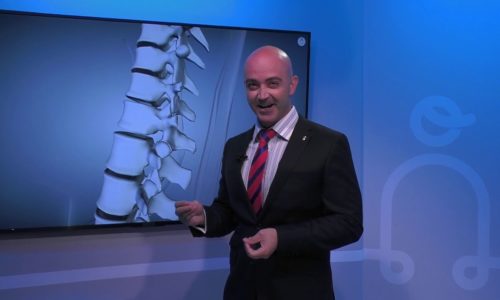Sciatica Basics l Smart Life |
Dr. Jose Mena, Interventional Spine Specialist with Miami Orthopedics and Sports Medicine Institute talks with Dr. Georgiy Brusovanik, Spine Surgeon with Baptist Health South Florida about sciatica and the potential treatments and surgeries.
Transcript
Today we’ll be talking about sciatica it’s a very very common condition that i see every single day joining me is dr georgie versavanik who happens to also see this type of complaint as well every single day so we’ll be talking to you about what is sciatica what are the treatments and what are the surgical options for sciatica welcome dr georgie brusselvanic here thank you doctor i’m a spine surgeon and i do see sciatica often so just to be clear sciatica is a very common word that’s that’s used to describe pain that sort of initiates in the lower back and goes down all the way to the leg which is debilitating horrific pain that in most patients happens on and off but in some patients actually is constant so for spine surgeon now sciatica exemplifies a number of conditions for example the sciatic nerve is a combination of six or seven different nerve segments so if a patient has pain going down to their big toe to me that implies that the problem probably comes from the second to last disc that same patient for example having pain going down to their heel or to their bottom of the foot is likely having problems from the bottom disc so sciatica is sort of a bit of a misnomer but that’s the term that we commonly use to refer to this condition correct and actually I say the same thing to my patients I say sciatica is a misnomer and basically it’s a constellation the nerve actually the main nerve that goes down on leg is the sciatic nerve so basically has contribution of all those nerves that we are alluding to and those patients most of the time is a compression of a nerve in that lumbar spine which we call radiculitis or radiculopathy and that’s basically what the sciatica entails so honestly I see this every single day you as well most of the patients there where they come to the office they’re looking for different treatment strategies we might both agree that sciatica has been treated conservatively about in your case it’s basically kind of the same right from the spine surgery point of view most of the time exactly to me a big difference is made by the patient’s story if a patient says that the pain comes and goes especially if their pain is worse with sitting or if their pain is worse with getting out of the car to me that’s a patient that likely has an inflammatory problem because if the nerve was actually compressed I would expect them to have that horrific pain going down the leg all the time so the vast majority of patients do have occasional breaks in pain which to me is sort of a sign of hope to me that means that that patient likely has a strong inflammatory component and if I send them that for example dr manna I know that a strong anti-inflammatory in the form for example of an injection may just cure them correct correct and actually let’s talk about causes because a lot of people sciatica what’s causing sciatica most of the time there’s something that is compressing the nerve or the the nerve in the back most of the time we see them that are discrimination that’s the most common cause of sciatica sometimes my video arthritis and sometimes might be medical they can have cancer or tumors in the spine and actually that can be compressing on the nerve but the vast majority of the patient is basically related to a nerve compression so in terms of treatments typically for my interventionalists most of the time i will start them on a physical therapy program if there’s no neurological symptoms i will start on an exercise program and most of the patients they do well some of those patients they might not better and we end up doing spinal injections and very subset of patients small subset of patients eventually will require a surgical consultation from your experience and your practice you see more or less that’s the same trend that you get across absolutely I would say one out of 10 patients who comes to my office really legitimately needs an operation they’ll never hear me say you need surgery it’s a very personal decision for patients and i’m not saving patients lives i’m just taking care of their pain and improving their quality of life but i’m very happy to say that for the most part patients with sciatica can avoid an operation typically when someone has a disc herniation the natural progress of the disease is actually resolution most of this those discriminations they tend to resolve however when people have arthritis mostly it’s a fixed lesion and some of those patients they might not respond favorably as the younger population tend to respond with the disc herniations so we’re talking from your perspective because my injection will be the same someone has a discrimination or someone has a has arthritis but from the surgeon’s perspective disc herniation versus arthritis in the back simple so imagine that disc if that disc tore and a little piece came out i can sneak in remove the little piece and sneak out and the patient will wake up and their pain will be gone if that same disc not looking like this in cross-section has become thinner and wider you can’t just sneak in and remove a little piece those patients either will get better with a disc replacement that’s a procedure where you remove the whole flat tire and put something that’s going to be a little taller it will restore the anatomy get patients actually taller the way they were 10-15 years or to the time before their pain began and the last option if the disc is beyond repair if what you call arthritis has overgrown the segment and it’s compressing the nerves and there’s deformity where the spine is actually turning curvy these patients benefit from the third type of surgery which is fusion surgery that’s where you improve the position of the spine and you fix it in place we very carefully placed fixation or actual screws so that’s good actually from our perspective we have only one type of spinal injection which is an epidural injection typically the transforming approach but from a spine surgery perspective we have three approaches either we have a microscopy or we have a fusion or we have this replacement any of those that is better than another one in terms of surgery like uh recovery time patients might do quicker one over the other one you know that’s an interesting question because um I feel that there’s just so many factors whether a patient is young or old or the patient has already had surgery and this is their revision trying to fix the whole problem or this is a primary operation you know there’s so many factors and I continue to be surprised I keep taking these patients into the or for sort of scary surgery to fix their backs and take away their pain and i tell them three weeks four weeks and a week later they come back to my office and they’re just happy walking with no pain so it’s hard for me to say i never judge anymore I always give them the benefit of the doubt no at the end listen at the end it’s actually patient care and actually doing what’s best for the patient thank you for joining me today in the smart live so hopefully we’ll have another talk soon thank you so much.








